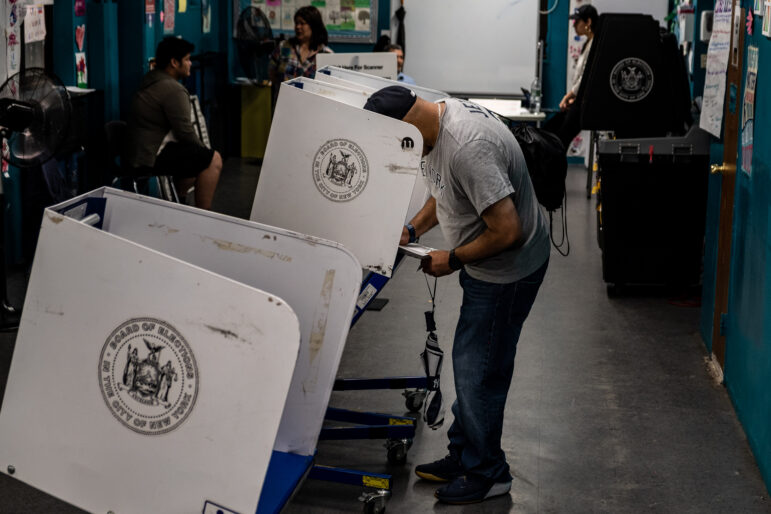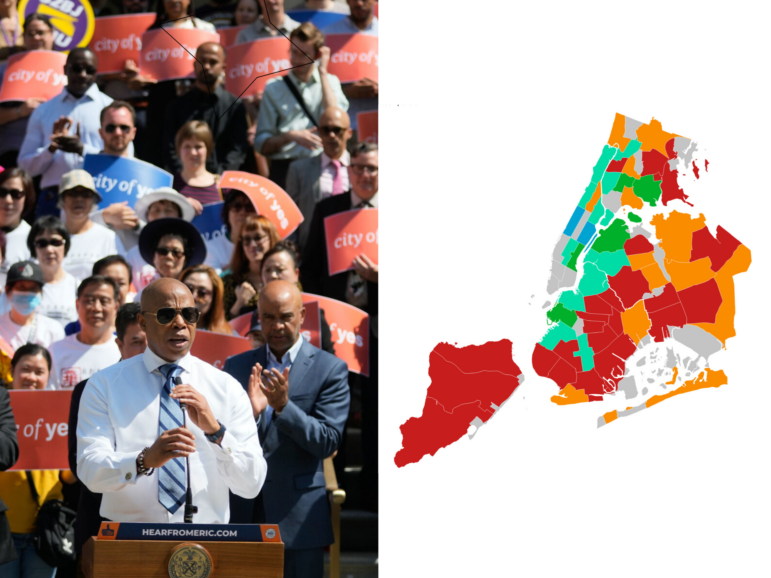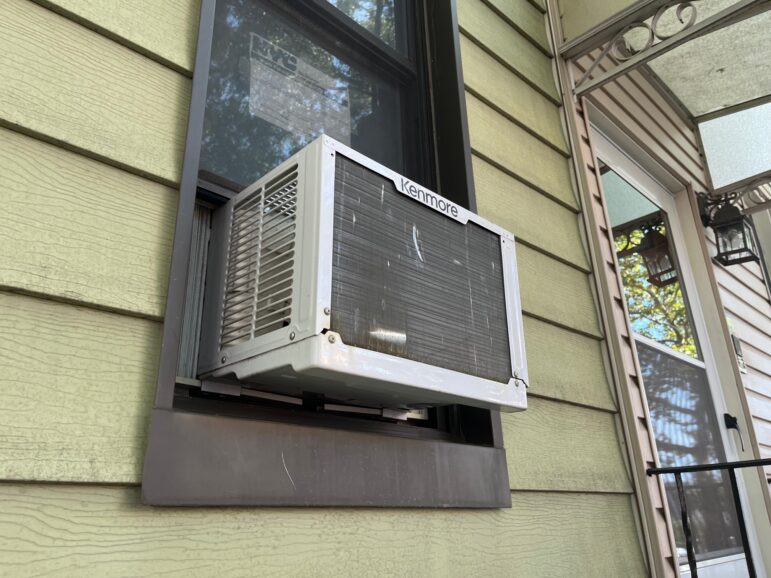
Gwynne Hogan
Karen Dunn has lived in the building since 2007. She says the protections tenants hoped the Loft Law would deliver have failed to materialize.
When tenants of a South Slope loft building learned they might be eligible for protection under the city’s Loft Law in 2014, they were ecstatic.
It would be a chance for them to finally have a venue to demand much needed upgrades to the building like reliable electric outlets, fixes to constant leaks that spawned small lakes inside their apartments, insulation for walls that froze in the winter and a sprinkler system that’s fit for residences.
“‘This is great,'” thought Karen Dunn, 60, a filmmaker who’d moved into what was a former automotive plant seven years earlier, wooed with her partner Katya Moorman from the Upper West Side by the massive windows with sweeping views of the East River and the Statue of Liberty. “‘Why don’t we see if we can get protection and bring it up to code.'”
In the three years since, they’ve gained protected tenant status. But they’re entering their seventh month without cooking gas and their first winter without heat, largely because the city’s Department of Buildings (DOB) granted the landlord a residential Certificate of Occupancy before the landlord made any of the required fixes to the building, according to the tenants and their attorneys.
“There is no way that this building should have had a Certificate of Occupancy issued, so either somebody wasn’t doing their job or somebody got paid off,” says attorney Michael Kozek, representing a group of seven tenants at 255 18th Street who are trying to contest the certificate through the Board of Standards and Appeals, an arm of city government that allows challenges to the city’s zoning code.
A second group of four tenants took a different path and sued the landlord, arguing in a lawsuit filed in September, that the owner, an LLC controlled by Chester Strulovich, also known as Yechezkel Strulovich—a prolific landlord behind some of the earliest loft conversions in Brooklyn, who is staving off another lawsuit from Israeli investors alleging he conned them out of upwards of $20 million—got the certificate of occupancy through fraud, conspiring with architects without doing any of the needed improvements.
The city’s Loft Law was crafted in the 1982 as a mechanism to legalize converted warehouses for residential use by bringing tenants—who often were living in dangerous conditions—out of the shadows. They’d get legal protections and rent-stabilized status, while the Loft Board provided oversight of landlords as they brought their buildings up to residential code.
The law was tweaked under then Mayor Bloomberg in 2010, opening another window for tenants to apply for coverage, which gave tenants in Brooklyn, who weren’t eligible previously because they moved into their buildings much later, a chance to legalize their apartments.
Tenants who can prove they lived in their lofts for a 12-month period during Jan. 1, 2008 and Dec. 31, 2009, are granted coverage and the Loft Board oversees the legalization process, setting milestones and deadlines on the route to bringing the building up to code and can impose fines if the landlord strays from schedule.
At the final step of the process, the DOB grants a Certificate of Occupancy, the building leaves control of the Loft Board, (which has in theory done its job), and the landlord is allowed to ask for a bump in rent to defray some of the costs of the improvements made.
In the case of 255 18th Street, the landlords skirted the Loft Board entirely, Kozek says, making it to the finish line before even passing go, despite glaring evidence the building didn’t meet residential code.
An elevator was decommissioned without DOB permits, bathrooms don’t have proper ventilation, the sprinkler system isn’t compliant with residential use, there’s the illegal gas piping that Con Edison shut off in May, much of which is documented in Department of Building violations and evaluations by two different architects the tenants hired to survey the building.
A report prepared by architect Arthur Atlas in May of 2014 noted there were “bizarre irregularities” in the Department of Building’s records. Not a single work permit has been filed at the building since 2000, according to DOB records. Atlas added that the “building does not confirm to either the New York City Building Code, the New York State Multiple Dwelling Law, or the New York City Zoning Resolution.”
“It is abundantly clear to me, having been involved with loft building conversion and legalization for over 35 years, that the Certificate of Occupancy for this building has been improperly issued, is significantly flawed and can easily be revoked,” he wrote.
John Peachy, the second architect hired by tenants, wrote a blistering report on Oct. 4, 2016, concluding, “the architect and the owner perpetrated a massive fraud that has endangered the occupants of the building.”
Most egregiously, the landlord was supposed to have moved an entire back wall back several feet from the lot line in order for apartments on that side to have legal light and air, both architects pointed out. The wall is still on the property line, they said.
“The subject building is a heinous example of Building Department incompetence and professional malpractice,” Peachy determined.
Despite the evidence detailed to the DOB in a letter from their attorney Kozek on Jan. 24, the city has refused to budge, eventually sending a letter on Nov. 11, nine months later, saying it didn’t have enough information to proceed.
The tactic of skirting the loft board by scoring a certificate of occupancy without the tenants’ knowledge, Kozek says, is yet another creative way landlords have found to wriggle around laws that were written to protect tenants.
He’s seen the tactic used by landlords in several other Brooklyn loft buildings he’s worked with.
Attorney David Brody, of Goldstein, Altschuler, Nahins & Goidel, P.C., refuted the tenants’ claims about the building and scoffed at the idea that his law was some how in cahoots with the landlord.
When asked about the allegations of tenants, their attorneys, and two architects, Brody said that the landlord had done some fixes to the building before 2000 that residents weren’t content with.
“The tenants do not believe it was enough to merit a Certificate of Occupancy and the owner is of the belief that it is,” Brody said. In court records, Brody similarly contested the tenants claims.
“The building has been properly legalized,” he said.
Brody said they are a few days away from securing permits for a temporary fix to the heating system.
“The process was taking longer than anybody wanted it to take,” he said. “We are doing our best to provide services that people are entitled to have.”
But now the landlord is now demanding a rent increase from tenants, which he’s allowed to do once he obtains the certificate of occupancy. He sued Moorman, Dunn and two other tenants who withheld the increase in housing court for non-payment, housing court records showed.
Dunn says the whole drawn-out process is maddening, and has them bouncing like ping pong balls among housing court, the Department of Buildings, the Board of Standards and Appeals, the Loft Board, all the while dogging the city with dozens of 311 complaints and racking up attorneys fees.
“I feel like the mouse that the cats have,” says Dunn, who added, she wouldn’t mind paying an increased rent if it meant her home of nine years was a safe place to live.
“Nobody will respond,” she says. “This building is the building they don’t want to look at.”
Department of Buildings spokesman Andrew Rudansky said the department, “has issued a number of violations to the owner of 255 18th Street in the course of an ongoing investigation.”
“We are continuing to review a number of issues previously raised by the building’s tenants.”









7 thoughts on “Loft Tenants Say City OK’d Their Dangerous Building”
I live in this building. It has been a rough 7 and 1/2 months without gas, but especially bad now that we have no heat. (Our heat is provided by gas blower heaters). An important note about the gas being shut-off. It was only done so after a few tenants all but demanded that the gas service be shut off by calling 311 over and over, and inviting the DOB into their apartments to the point where the DOB could no longer ignore that there was work done without permits. The tenants lawyers had warned them that this could be the result and that getting gas service restored was a long, drawn out process. Some of that work was by tenants who installed gas dryers in their apartments. Had they not made engaged in these repeated efforts to have violations placed for the gas lines, the building would continue to have gas and all of us would still be able to cook and more importantly now, HAVE HEAT in our apartments.
I also live in the building and I have to point out a few inaccuracies with what you wrote.
There were a few people who were very loud about their concerns for fire safety but they are actually not the people who caused the gas to be shut off. A tenant, who was not represented by any lawyer, smelled gas in the hallway and called 311. That is what led an inspector from the gas company to come and eventually turn off access to gas.
There are some facts that you overlook when you start to blame your neighbors for not having heat. First, the gas was shut off because the building IS a fire hazard. Yes we could have gas right now but we would be living in an active fire hazard. Second, our landlord had never brought the building up to code and if anything, has let it slowly fall apart. Therefore, if you want to blame someone for our gas being shut off, you should blame the landlord, not the people calling for attention to the problem. It’s like blaming the whistleblowers for revealing corruption and ignoring the corruption exists.
All this is to say, put the anger and blame towards the actual culprit, our landlord and the corrupt DOB that allowed this to happen. Stop blaming your neighbors who just want to live in a safe, warm home.
Pingback: The Down Low: Calling Santa From A Streetcorner, The History Of A Gendered Hat & Other Stories You Shouldn’t Miss - BKLYNER
“the architect and the owner perpetrated a massive fraud that has endangered the occupants of the building.”
Yup, when Deblasio was Public Advocate residents of HPD built buildings, lofts reached out to him with no response. We called Emma Wolf his chief of staff and due to the fact that BDB listens to REBNY and NOT tenants we got no where. When she left to reach out to Dominick Williams who was promoted to Chief of Staff, and again ignored by the Public Advocates Office.
I also live in this building where a wall to the outside is now a solid sheet of ice. Building tenants have been reaching out to public officials trying to find anyone to help while the landlords offered some tenants cheap electric heaters not up to the task of heating the entire apartment with no thermostats on them meaning they will either be on all of the time (and very expensive) or where you are constantly turning them on and off. Im sure the thermostat versions of these heaters were only a few bucks more but this is a landlord who will spend the least amount of money on everything even at the risk of tenant safety.
Basically the Loft Law marries tenants to their con slum landlords and managing agents, at a cost both emotional and financial.
To the tenants of this building: Curious to know what the current state of affairs is in the building? Has the City forced the landlord to improve conditions? I live in the neighborhood, and occasionally see construction workers about the building – are they working on the structural issues / facade, or generally working to improve the health of the building?